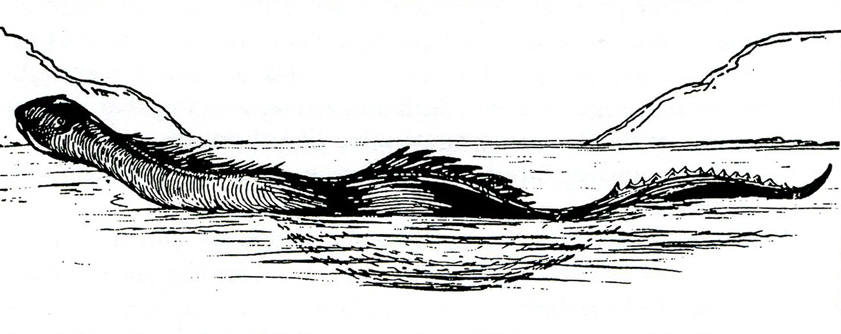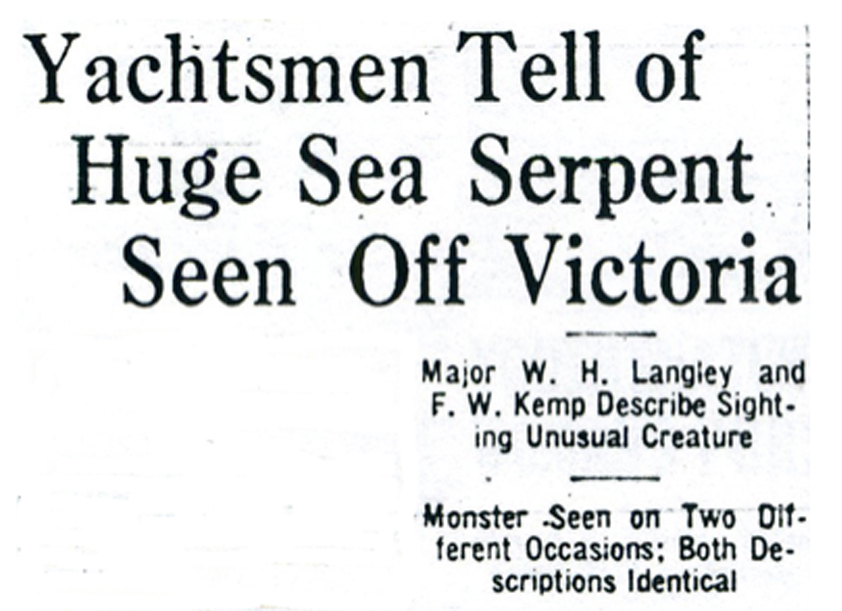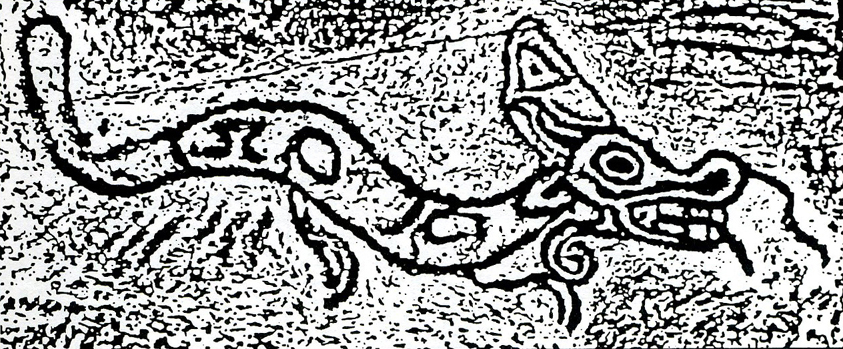Kemp Sketch (Victoria Daily Times, 20 Oct 1933)
Caddy came to broad public attention in 1933, the same year
as Nessie, its Loch Ness cousin. Archie Wills, then editor of the
Victoria Daily Times, seized on reports by people he considered as
reliable witnesses to feature, in imitation of the English press, a
local "sea-serpent". Intensive coverage of local sightings starting
October 5 of that year stimulated an avalanche of responses
about earlier appearances, opinions about the nature of the beast,
and a contest to name the "monster".
Zoological authorities consulted at the time expressed interest.
Dr. C. McLean Fraser, F.R.S.C., head of the Zoology Department at the University of British Columbia was of the opinion that “Until someone gets a lasso around one of these things we will never be able to get much farther. It is possible there are such things."
Besides traditional stories about Caddy, artifacts attest
to aboriginal knowledge of the creature. Petroglyphs
found in various areas of the coast depict an animal similar
to Caddy. An atlatl (spear thrower) found in the Skagit Riger
(WA) and carbon-dated to 1,700(+/- 100) years before the
present also shows an animal resembling the petroglyphs.
An important milestone in Caddy-lore was the discovery of a
strange animal in the stomach of a sperm whale at a Queen
Charlotte Islands in 1937. The Naden carcass, so named
after the whaling station at Naden Harbour, was thought at
the time to be a juvenile Caddy. Unfortunately, the specimen
was lost in transit.
Click here for more information on the Naden Harbor Carcass.
A systematic cryptozoological analysis of the evidence for Caddy was included by Heuvelmans (1968) as part of his world-wide survey of marine cryptids. A more focused regional enquiry was published by LeBlond and Sibert (1973) and brought to light a number of new sightings. The creation of the British Columbia Scientific Cryptozoology Club in 1989 stimulated further enquiries and led to the publication by LeBlond and Bousfield (1995) of an overview of the knowledge available at the time. An updated version by LeBlond, Kirk and Walton was published in 2014; it contains a list of all documented sightings to that date and a statistical analysis of the data.
In spite of the accumulated eye-witness reports, and attempts at scientific description, Caddy remains a cryptid: an animal whose existence and nature is still in doubt for lack of a specimen.
Caddy had of course often been glimpsed by mariners well before that time. It was also well known to the native tribes of the coast. Fishermen acquainted with that folklore suggested "Old Hiaschuckaluck" as an appropriate name for the creature (a variant of hiyitli'ik of Manhousat lore). However, the more euphonic Cadborosaurus was preferred, after Victoria's Cadboro Bay, the site of numerous sightings.
The original letter suggesting the name Cadborosaurus was somewhat tongue-in-cheek; the signer, I. Vacedun could not be traced. His address seemed to be that of a local jail, and Wills suspected that the letter might have originated from a reporter on the rival newspaper, the Daily Colonist.
Heuvelmans, Bernard, 1968. In the Wake of the Sea-Serpents. Hill & Wang, New York.
Hill, Beth and Ray, 1974. Indian Petroglyphs of the Pacific Northwest. Hancock House, Surrey, B.C.
LeBlond, P. H. and J. Sibert, 1973. “Observations of large unidentified marine animals in British Columbia and adjacent waters.” Manuscript Report 28, Institute of Oceanography, University of B.C.
LeBlond, P.H and E.L. Bousfield, 1995. Cadborosaurus, survivor from the deep. Horsdal & Schubart, Victoria.
LeBlond, P.H., J..Kirk III, and J. Walton, 2014. Discovering Cadborosaurus. Hancock House, Surrey, B.C.
The News Editor of the Victoria Daily Times.
Dear Sir,
Why not Cadborosaurus as a name for our sea pet? It’s only fair that the
locality from which he was most often sighted and Possibly first discovered,
should get the credit from Posterity when he may have retired to the limbo
of the other monsters of land and sea. Besides, the name is euphonious,
and, if too long, can be shortened to “Caddy” as a pet name, especially for
the lucky ones who see him from the nine- teenth hole at Oak Bay.
Yours truly, I. Vacedun, Wilkinson Road, Saanich
Petroglyph from the Monsell site, Nanaimo river (Hill and Hill, 1974)
Victoria Daily Times Headline, 20 Oct 1933)




